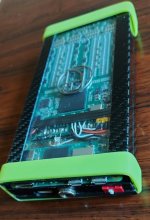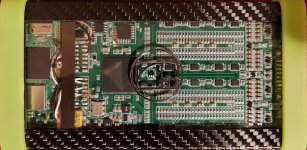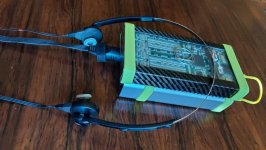He should just get one of the guys here to sign an NDA and write the code for him ....How hard can it possibly be
Ego, the hardest thing found in the universe...
Soeren, where are you?
People payed you hundreds of thousands of euros for your DACs, don't you think you should invest a little time to tweak the firmware in order to improve the clocking? You are seriously damaging your brand here. I have personally advertised for your DACs, I don't think I can do that any more if you go on ignoring your customers.
People payed you hundreds of thousands of euros for your DACs, don't you think you should invest a little time to tweak the firmware in order to improve the clocking? You are seriously damaging your brand here. I have personally advertised for your DACs, I don't think I can do that any more if you go on ignoring your customers.
Soeren, where are you?
People payed you hundreds of thousands of euros for your DACs, don't you think you should invest a little time to tweak the firmware in order to improve the clocking? You are seriously damaging your brand here. I have personally advertised for your DACs, I don't think I can do that any more if you go on ignoring your customers.
You seemed to have missed the memo. This dac doesn't have a clocking problem, nor any other issue.
Dear all,
I am trying to contact SØren/Soekris for my dam1021 sent at the end of january for repairing, but oddly since then nobody answered to my various emails asking for information (SØren is always kind and usually answers within 1-2 days) . I will try to call by phone unless any of you is aware of a temporary company closing o similar. Thanks a lot!
I am trying to contact SØren/Soekris for my dam1021 sent at the end of january for repairing, but oddly since then nobody answered to my various emails asking for information (SØren is always kind and usually answers within 1-2 days) . I will try to call by phone unless any of you is aware of a temporary company closing o similar. Thanks a lot!
Last edited:
On the positive side, there are news from the community –
Happy to show the latest iteration on the theme of embedded soekris’es.
Smaller and half weight but ten time the storage of the premium Sony Walkman Signature DAP unit.
Best of all, cost is just a tenth of that Sony.
Here is a system with dedicated components, all portable for a music nomad.
Comfortable portability in this context, depends on several key enablers as
In this setup, there's a music Server that stores and indexes your music,
A music Player that plays digital audio data through an earphones or amplifier and loudspeakers, and a
Control-point to browse the music collection and select music to play. This Control-point sends your selections to the music Player (either one at a time or as a playlist containing several items), and the music player reads the audio data from the music server and plays it for you.
This computational power is delivered by Raspberry Pi Zero 2 W is RP3A0, a custom-built system-in-package designed by Raspberry Pi with a suitable form factor.
MinimServer NAS music Server software allows to make any combination of selections in any order. For example, a search for a violin concerto by artist, then composer, then conductor, then orchestra, then album. Alternatively, a search first by composer, then select violin concertos, then artist, then orchestra, then conductor (or any other order of selection). At each step you see all the music that matches your previous selections.
Large data-storage is available as a small low-power and fast SSD. The, otherwise common small but expensive, microSDXC memory cards, today has a max capacity of 1TB and it is said they are not durable in such read-write applications.
The music Player consists of two components –
UPnP the software driving the
Digital-to-analog audio transducer component, a Soekris Engineering discrete R-2R sign magnitude DAC technology, as a small OEM module designed to be integrated. Input from The computer is I2S with reclocking FIFO. Clocking is with low jitter digital programmable oscillator on board.
Direct point-to-point W-Lan is a convenient and comfortable means to join the portable components, with bit-perfect transferring.
Battery power for 4-5 hours is probably enough in this context
These components are fit in a wearable rugged cabinet with a fitting form-factor and weight as a mobile phone.
Finally, the control Point is a mobile phone or a pad running an app like the BubbleUPnP or any other DLNA-based software on Android or IOS.
So, in practical use, there are the two units as above – music Server / Player and Control Point plus a small amplifier for earphones and portable-speakers.
.The specific implementation of the above:
Happy to show the latest iteration on the theme of embedded soekris’es.
Smaller and half weight but ten time the storage of the premium Sony Walkman Signature DAP unit.
Best of all, cost is just a tenth of that Sony.
Here is a system with dedicated components, all portable for a music nomad.
Comfortable portability in this context, depends on several key enablers as
- Open industry standards allowing a multi-vendor design approach
- Computational power with low space- and power requirements
- Audio components of highest representation qualities
- Nas server software
- large data-storage
- Direct point-to-point W-Lan, independent of any central resource.
- battery power for 4-5 hours and
- All embedded in a wearable rugged cabinet
In this setup, there's a music Server that stores and indexes your music,
A music Player that plays digital audio data through an earphones or amplifier and loudspeakers, and a
Control-point to browse the music collection and select music to play. This Control-point sends your selections to the music Player (either one at a time or as a playlist containing several items), and the music player reads the audio data from the music server and plays it for you.
This computational power is delivered by Raspberry Pi Zero 2 W is RP3A0, a custom-built system-in-package designed by Raspberry Pi with a suitable form factor.
MinimServer NAS music Server software allows to make any combination of selections in any order. For example, a search for a violin concerto by artist, then composer, then conductor, then orchestra, then album. Alternatively, a search first by composer, then select violin concertos, then artist, then orchestra, then conductor (or any other order of selection). At each step you see all the music that matches your previous selections.
Large data-storage is available as a small low-power and fast SSD. The, otherwise common small but expensive, microSDXC memory cards, today has a max capacity of 1TB and it is said they are not durable in such read-write applications.
The music Player consists of two components –
UPnP the software driving the
Digital-to-analog audio transducer component, a Soekris Engineering discrete R-2R sign magnitude DAC technology, as a small OEM module designed to be integrated. Input from The computer is I2S with reclocking FIFO. Clocking is with low jitter digital programmable oscillator on board.
Direct point-to-point W-Lan is a convenient and comfortable means to join the portable components, with bit-perfect transferring.
Battery power for 4-5 hours is probably enough in this context
These components are fit in a wearable rugged cabinet with a fitting form-factor and weight as a mobile phone.
Finally, the control Point is a mobile phone or a pad running an app like the BubbleUPnP or any other DLNA-based software on Android or IOS.
So, in practical use, there are the two units as above – music Server / Player and Control Point plus a small amplifier for earphones and portable-speakers.
.The specific implementation of the above:
- Raspberry PI 2W - quad-core 64-bit ARM Cortex-A53 processor clocked at 1GHz and 512MB of SDRAM, WLan, HDMI &USB
- WD Blue 3D NAND SSD M.2 2TB SSD, SUITCAN M.2-to-USB-adapter,
- Debian 11 64bit O/S, Java (JRE 11)
- Minimserver 2 for ARM 8 64bit & Minimwatch as the music server
- GmediaRender as the music Player software
- Soekris DAM 1121-02
- PNY rechargeable battery 5V 2500mAh, Recom RFM-0505S DC/DC isolated -5V
- Bespoke cabinet with outer layer of flexing 2-ply woven 0.5mm carbon-fiber laminate and a rigid inner frame of glued 2mm pull-truded carbon fiber profiles with glass front. All joints are glued and point-to-point soldering. Optional silicon corner straps.
- The outer size -145 x 72 x 20mm and weight - 233grams is close to a mobile phone.
Attachments
I am using DAM1021 for last 3 years. It was working well. The DAC is connected with RPI4 through I2S interface. Recently I changed the PSU of RPI4. Now left channel of XLR output is giving low sound than right channel of XLR. The sound through RCA (buffered and raw) is perfectly okay. I checked the connection thoroughly, checked the cable and preamp, there is no problem. I am using Parasound Halo A21 with P5 preamp. Both the speakers Tannoy Cheviot is okay as well. Can someone please help.
You need to switch channels on all parts of your system one-by-one to find the reason. It doesnt seem to be the DAC... The 1021 is single out so there is no native differential out (XLR). If the RAW and RCA is OK, its not the DAC. All points to the cables or the preamp.
//
//
Thanks for your reply. It is ok now. Following caused the problem:
1. One of the cables had loose connection.
2. I connected the XLR connectors with Parasound P6 preamp and also the unbuffered RCA connection was connected with Cayin P300B amplifier. I found the overall volume level was very low from the speaker that was running using XLR connectors when the Cayin is turned off, but volume gets normal when I turn on the Cayin (connected by unbuffered RCA). Volume remains normal when Cayin is connected via buffered RCA.
Thanks anyway.
1. One of the cables had loose connection.
2. I connected the XLR connectors with Parasound P6 preamp and also the unbuffered RCA connection was connected with Cayin P300B amplifier. I found the overall volume level was very low from the speaker that was running using XLR connectors when the Cayin is turned off, but volume gets normal when I turn on the Cayin (connected by unbuffered RCA). Volume remains normal when Cayin is connected via buffered RCA.
Thanks anyway.
- Home
- Vendor's Bazaar
- Reference DAC Module - Discrete R-2R Sign Magnitude 24 bit 384 KHz


